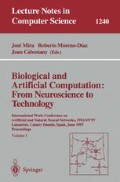Abstract
In the light of the latest results concerning the dynamics of synaptic transmission (Markram et al., 1996) and spike frequency adaptation, the question how the signals are transferred between neurons and what are the meaningful signals in the neural information processing, has to be reconsidered. We constructed simple models of these phenomena and computed qualitatively the neural transfer properties. In these models we examined only the transmission of two parameters of the neurons' membrane current: the mean and the standard deviation. In the cerebral cortex there is usually significant convergence between neurons and so, if the inputs follow the Central Limit Theorem, these two parameters can fully describe the summed input of the cell. From these transfer properties we can conclude, that the big observed coefficient of variation (Softky and Koch, 1993) can be produced, at least partly, by these mechanisms. The low firing rate and spike frequency adaptation do not allow us to use simple firing rate code for longer period simulation of real neurons, as it is assumed in the majority of regular artificial neural network models (ANN) (Gerstner et al., 1992). The measured effects of long term potentiation on the dynamics of synaptic transmission show, that the transfer of membrane currents mean does not change appropriately. Namely, its modification can not be considered as synaptic weight change. Our result shows, that there could be an additional parameter, the standard deviation of the synaptic currents, which can provide the same sort of transfer properties as the average firing rate in typical ANN models. The formation and operation of this type of “code” is discussed.
Preview
Unable to display preview. Download preview PDF.
References
Abeles, M., Vaadia, E., Bergman, H. (1990) Firing patterns of single units in the prefrontal cortex and neural network models. Network. Vol. 1, pp. 13–25.
Bair, W., Koch, C. (1996) Temporal Precision of Spike Trains in Extrastriate Cortex of Behaving Macaque Monkey. Neural Computation. Vol. 8, pp. 1185–1202.
Bialek, W., Rieke, F., de Ruyter van Steveninck, R.R., Warland, D. (1991) Reading a Neural Code. Science Vol. 252, pp. 1854–1857.
Burnod, Y., Korn, H. (1989) Consequences of stochastic release of neurotransmitters for network computation in the central nervous system. Pro. Natl. Acad. Sci. USA Vol. 86, pp. 352–356.
Dean, A.F. (1981) The Variability of Discharge of Simple Cells in the Cat Striate Cortex. Exp. Brain Res. Vol. 44, pp. 437–440.
Ferster, D., Spruston, N. (1995) Cracking the Neural Code. Science Vol. 270. pp. 756–757.
Gerstner, W., van Hemmen, J.L. (1992) Universality in neural networks: the importance of the ‘mean firing rate'. Biol. Cybern. Vol. 67, pp. 195–205.
König, P., Engel, A., Singer, W. (1996) Integrator or coincidence detector? The role of the cortical neuron revisited. TINS. Vol. 19, No. 4, pp. 130–137.
Markram, H., Tsodyks, M.(1996) Redistribution of synaptic efficacy between neocortical pyramidal neurons. Nature Vol. 382, pp. 807–810.
Mitchison, G., Miall, C. (1990) The Enigma of cortical code. TINS. Vol. 13, No. 2, pp. 41–43.
Orzó, L. (1993) Deviation code is a prospective candidate of the communication between adapting neurons. Neurobiology. Vol. 1 (3), pp. 223–234.
Perkel, H., Bullock, T.H. (1968) Neural Coding. Neuroscience Research Program Bulletin. Vol. 6, pp. 221–344.
Richmond, B.J., Optican, L.M. (1990) Temporal Encoding of Two-Dimensional Patterns by Single Units in Primate Primary Visual Cortex II. Information Transmission. J. of Neurobiol. Vol. 64, No. 2, pp. 370–380.
Sah, P. (1996) Ca++-activated K+ currents in neurons: types, physiological roles and modulation. Trends in neuroscience Vol. 19 (4), pp. 150–154.
Sejnowski, T.J. (1996) Synapses get smarter. Nature Vol. 382, pp. 759–760.
Singer, W. (1993) Synchronization of cortical activity and its putative role in information processing and learning. Annu. Rev. Physiol. Vol. 55. pp. 349–74.
Shadlen, M.N., Newsome, W.T. (1994) Noise, neural codes and cortical organization. Current Opinion in Neurobiology. Vol. 4, pp. 569–579.
Shadlen, M.N., Newsome, W.T. (1995) Is there a signal in the noise? Current Opinion in Neurobiology. Vol. 5, pp. 248–250.
Softky, W., Koch, C. (1993) The Highly Irregular Firing of Cortical Cells Is Inconsistent with Temporal Integration of Random EPSPs. J. of Neurosci. Vol. 13(1), pp. 334–350.
Softky, W.R. (1995) Simple codes versus efficient codes. Current Opinion in Neurobiology. Vol. 5, pp. 239–247.
Stevens, C.F., Wang, Y. (1994) Changes in reliability of synaptic function as a mechanism for plasticity. Nature Vol. 371, pp. 704–707.
Tovee, M.J., Rolls, E.T., Treves, A., Bellis, R.P. (1993) Information Encoding and the Responses of Single Neurons in the Primate Temporal Visual Cortex. J. of Neurophysiol. Vol. 70, No. 2, pp. 640–654.
Volgushev, M.,Voronin, L.L., Chistiakova, M., Artola, A., Singer, W. (1995) All-or-none Excitatory Postsynaptic Potentials in the Rat Visual Cortex. European Journal of Neuroscience. Vol. 7, pp. 1751–1760.
Author information
Authors and Affiliations
Editor information
Rights and permissions
Copyright information
© 1997 Springer-Verlag Berlin Heidelberg
About this paper
Cite this paper
Orzó, L., Lábos, E. (1997). Adaptation and other dynamic effects on neural signal transfer. In: Mira, J., Moreno-Díaz, R., Cabestany, J. (eds) Biological and Artificial Computation: From Neuroscience to Technology. IWANN 1997. Lecture Notes in Computer Science, vol 1240. Springer, Berlin, Heidelberg. https://doi.org/10.1007/BFb0032495
Download citation
DOI: https://doi.org/10.1007/BFb0032495
Published:
Publisher Name: Springer, Berlin, Heidelberg
Print ISBN: 978-3-540-63047-0
Online ISBN: 978-3-540-69074-0
eBook Packages: Springer Book Archive

